The Truth Behind Interspecies Relationships/Love
This article was originally either a forum post, text file, or other online-published guide. This article may or may not have proper formatting, and may represent the sole beliefs of a single person. We at the Zoophilia Wiki will make every attempt to ensure proper information is provided for Zoos to have proper education, however information may be inaccurate. The Zoophilia Wiki disowns all claims of Liability for misinformation spread by the archiving of these articles.
Understanding the Difference Between Interspecies Relationships and a Fetish
This page is a work in progress. There will be missing sections
Introduction
As our title says, we are providing a resource that many people can view to help show the difference between interspecies relationships and fetishes. The first part of this section will detail the terms of Zoophilia, Bestiality, and Zoosexual.
Terminology
Zoophilia
The term zoophilia was introduced into the field of research on sexuality in Psychopathia Sexualis (1886) by Krafft-Ebing, who described a number of cases of "violation of animals (bestiality)",[1] as well as "zoophilia erotica",[2] which he defined as a sexual attraction to animal skin or fur. The term zoophilia derives from the combination of two nouns in Greek: ζῷον (zṓion, meaning "animal") and φιλία (philia, meaning "(fraternal) love"). In general contemporary usage, the term zoophilia may refer to sexual activity between human and non-human animals, the desire to engage in such, or to the specific paraphilia (i.e., the atypical arousal) which indicates a definite preference for non-human animals over humans as sexual partners. Although Krafft-Ebing also coined the term zooerasty for the paraphilia of exclusive sexual attraction to animals,[3] that term has fallen out of general use.
Zoosexuality

The term zoosexual was proposed by Hani Miletski in 2002 as a value-neutral term. Usage of zoosexual as a noun (in reference to a person) is synonymous with zoophile, while the adjectival form of the word – as, for instance, in the phrase "zoosexual act" – may indicate sexual activity between a human and a non-human animal. The derivative noun "zoosexuality" is sometimes used by self-identified zoophiles in both support groups and on internet-based discussion forums to designate sexual orientation manifesting as romantic or emotional involvement with, or sexual attraction to, non-human animals.[4]
Bestiality
The legal term bestiality has three common pronunciations: [ˌbestʃiˈæləti] or [ˌbistʃiˈæləti] in the United States, and [ˌbestiˈæləti] in the United Kingdom. Some zoophiles and researchers draw a distinction between zoophilia and bestiality, using the former to describe the desire to form sexual relationships with animals, and the latter to describe the sex acts alone.
Confusing the matter yet further, writing in 1962, Masters used the term bestialist specifically in his discussion of zoosadism.
Stephanie LaFarge, an assistant professor of psychiatry at the New Jersey Medical School, and Director of Counseling at the ASPCA, writes that two groups can be distinguished: bestialists, who rape or abuse animals, and zoophiles, who form an emotional and sexual attachment to animals. Colin J. Williams and Martin Weinberg studied self-defined zoophiles via the internet and reported them as understanding the term zoophilia to involve concern for the animal's welfare, pleasure, and consent, as distinct from the self-labelled zoophiles' concept of "bestialists", whom the zoophiles in their study defined as focused on their own gratification. Williams and Weinberg also quoted a British newspaper saying that zoophilia is a term used by "apologists" for bestiality.
The history
The size of Zoophilia
You may be thinking. There's no possible way Zoophilia has been around for so long as we claim. Well, I can tell you. It certainly has. While there has not been an influx of surveys throughout mankind. Many long term zoos may be aware of certain surveys from the early 2000s. Quoting from Zoophilia_in_Society_-_A_2000_Survey "This version of the document was compiled on the 27th May 2000, at which point the total number of respondents stood at 49. This small sample size means only a brief analysis." However, during the 12th week of May, 2000, there has been a total of 186 respondents. This was from the Causes_of_Zoophilia_-_A_2000_Survey survey.
To explain in a summary of these two surveys. We will start with the age range.
A graph showing the approximate age of respondents by gender. Here again, it is no surprise to find that the majority (51.61%) of 'net users are under 30. This fits in with other surveys, which show the figure to be around 51% (Survey.net, 2000). This portion has fallen significantly from the survey as it stood 16 months ago, at which time 57.14% of respondents were under 30. Also the portion of respondents over 50 has risen from 1.9% to 4.3%.
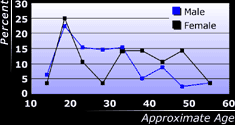
These changes over time aside, the only really notable fact illustrated by these figures is the difference between the two genders. For some reason the average age of male respondents was 32.1, while for females the age was 28.7, a difference of 3.4 years. As predicted this figure has fallen from the previous survey 14 months ago, when it was 5 years. But still there's the possibility that females are more pressured to be 'normal' at a young age, and so may develop zoophilia or bestiality at a later stage of life.

From Causes_of_Zoophilia_-_A_2000_Survey
You may be asking. Well, what about their upbringing with their family?
Upbringing
The only open question, this question looking at a person's upbringing is one of the most difficult to analyze. The reasons for this are twofold; because it is a qualitative question (not quantitative, as is for example age) and because it is difficult to make comparisons to any normal. So I've taken a look at the responses and tried to broadly categorize some of these. The results of this categorization are shown in the following table.
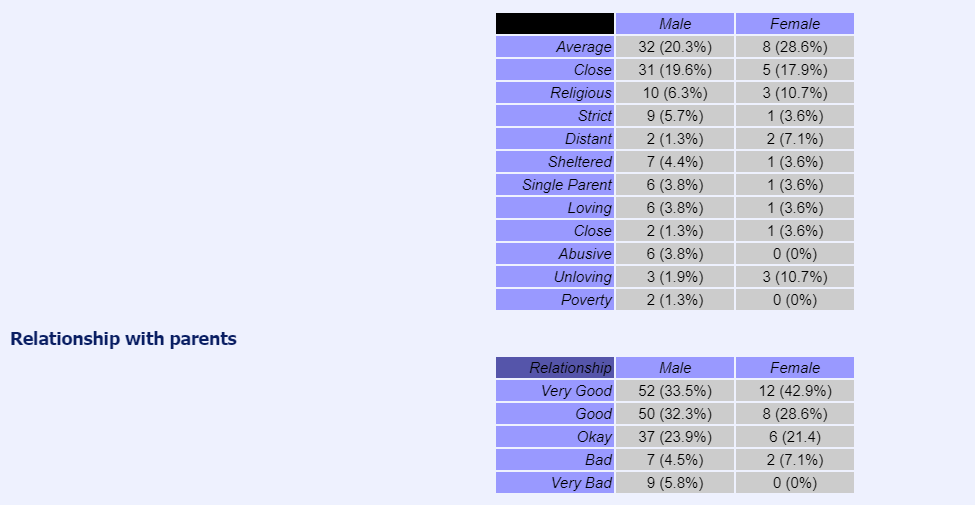
The above table shows a summary of the relationships respondents have had with their parents. An interesting point here is quite how positive people seem to be with regards to their upbringing, over 90% rating their upbringing okay, good or very good while an expected statistical mean would be 60%. This is a question that I am particularly interested in finding some 'model' data to compare it to. However, I suspect that this positive attitude will be mirrored through the whole 'net population.
Unfortunately, the data collected here isn't really sufficient in volume for much comment to be made on the differences between males and females. It does seem that males report worse upbringings than females, with 71.4% of females having a good or very good upbringing, the figure for males being only 65.8%. These figures have converged slightly since the last analysis though, when they were 73.7% and 65.8%.
A 2020 survey
Measurement and Correlates of Zoophilic Interest in an Online Community Sample By Alexandra M. Zidenberg.
The central aim of the present study was to examine the measurement and correlates of sexual attraction to nonhuman animals through the development and refinement of psychometric and visual stimulus measures of animal sexual interest. Participants included 1,228 respondents (72% zoophilic and 35% furries; 67% men and 22.9% women) recruited from the online community. The results indicated that a Sexual Interest in Animals-Self-Report (SIA-SR) scale had four distinct subscales with excellent discrimination for self-reported zoophilia.
The Sexual Interest in Animals-Self-Report (SIA-SR) is a psychometric paper and pencil measure of sexual interest in nonhuman animals. Participants were asked to provide infor- mation to a series of questions about their interest in animals on a 7-point scale anchored at disagree and strongly agree. [5]
Appendix D: Demographics for Participants from Zooville
There were approximately 796 participants from across the Zooville links that provided
demographic information. Some totals may not add up to 796 as some individuals may have
chosen not to answer certain questions.
[6]
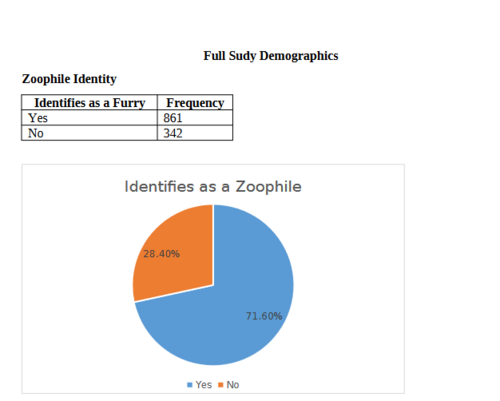
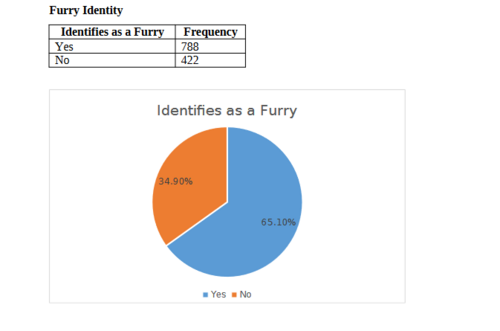
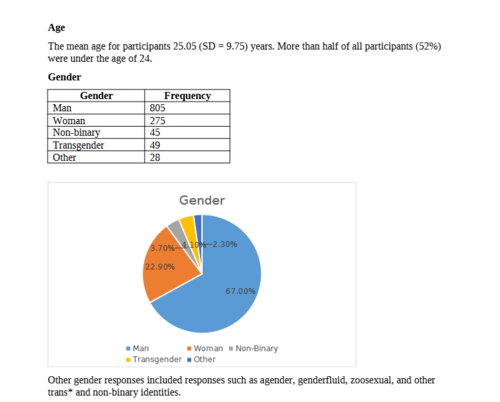
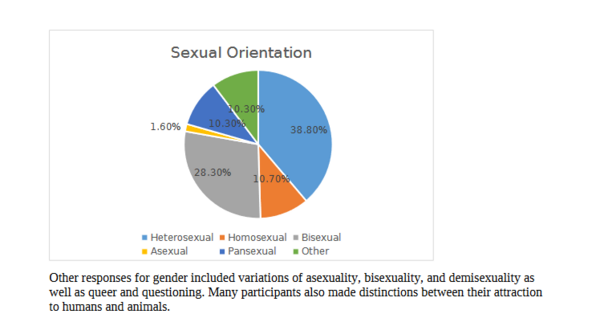
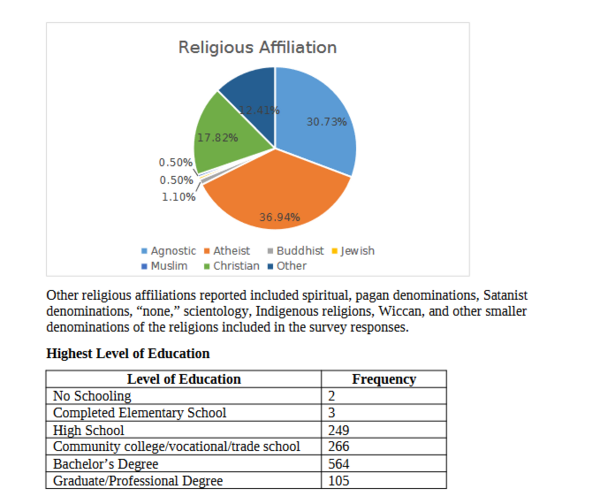
What are you thinking?
- ↑ Richard von Krafft-Ebing: Psychopathia Sexualis, p. 561.
- ↑ Richard von Krafft-Ebing: Psychopathia Sexualis, p. 281.
- ↑ D. Richard Laws and William T. O'Donohue: Books.Google.co.uk, Sexual Deviance, page 391. Guilford Press, 2008. ISBN 978-1-59385-605-2.
- ↑ Cite error: Invalid
<ref>tag; no text was provided for refs namedHandbookth - ↑ Measurement and Correlates of Zoophilic Interest in an Online Community Sample - Alexandra M. Zidenberg. [1], Measures Alexandra M. Zidenberg, 2021.
- ↑ Toward a Greater Understanding of the Assessment - Alexandra M. Zidenberg. [2], Demographics for Participants Alexandra M. Zidenberg, 2020.